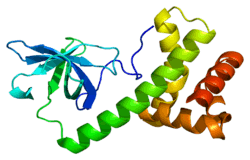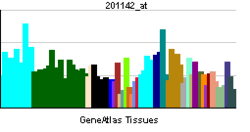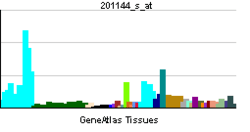EIF2S1
| View/Edit Human | View/Edit Mouse |
Eukaryotic translation initiation factor 2 subunit 1 (eIF2α) is a protein that in humans is encoded by the EIF2S1 gene.[3][4]
Function
The protein encoded by this gene is the alpha (α) subunit of the translation initiation factor eIF2 complex which catalyzes an early regulated step of protein synthesis initiation, promoting the binding of the initiator tRNA (Met-tRNAiMet) to 40S ribosomal subunits. Binding occurs as a ternary complex of methionyl-tRNA, eIF2, and GTP. eIF2 is composed of 3 nonidentical subunits, alpha (α, 36 kD, this article), beta (β, 38 kD), and gamma (γ, 52 kD). The rate of formation of the ternary complex is modulated by the phosphorylation state of eIF2α.[4]
Clinical significance
After reperfusion following brain ischemia, there is inhibition of neuron protein synthesis due to phosphorylation of eIF2α. There is colocalization between phosphorylated eIF2α and cytosolic cytochrome c, which is released from mitochondria in apoptosis. Phosphorylated Eif2-alpha appeared before cytochrome c release, suggesting that phosphorylation of eIF2α triggers cytochrome c release during apoptotic cell death.[5]
Mice heterozygous for the S51A mutation become obese and diabetic on a high-fat diet. Glucose intolerance resulted from reduced insulin secretion, defective transport of proinsulin, and a reduced number of insulin granules in beta cells. Hence proper functioning of eIF2α appears essential for preventing diet-induced type II diabetes.[6]
Dephosphorylation inhibitors
Salubrinal is a selective inhibitor of enzymes that dephosphorylate eIF2α.[7] Salubrinal also blocks eIF2α dephosphorylation by a herpes simplex virus protein and inhibits viral replication. eIF2α phosphorylation is cytoprotective during endoplasmic reticulum stress.[8][9]
See also
References
- ↑ "Human PubMed Reference:".
- ↑ "Mouse PubMed Reference:".
- ↑ Ernst H, Duncan RF, Hershey JW (Mar 1987). "Cloning and sequencing of complementary DNAs encoding the alpha-subunit of translational initiation factor eIF-2. Characterization of the protein and its messenger RNA". J Biol Chem. 262 (3): 1206–12. PMID 2948954.
- 1 2 "Entrez Gene: EIF2S1 eukaryotic translation initiation factor 2, subunit 1 alpha, 35kDa". National Center for Biotechnology Information, U.S. National Library of Medicine. Retrieved 2010-10-05.
- ↑ Page AB, Owen CR, Kumar R, Miller JM, Rafols JA, White BC, DeGracia DJ, Krause GS (July 2003). "Persistent eIF2alpha(P) is colocalized with cytoplasmic cytochrome c in vulnerable hippocampal neurons after 4 hours of reperfusion following 10-minute complete brain ischemia". Acta Neuropathol. 106 (1): 8–16. doi:10.1007/s00401-003-0693-2. PMID 12687390.
- ↑ Scheuner D, Vander Mierde D, Song B, Flamez D, Creemers JW, Tsukamoto K, Ribick M, Schuit FC, Kaufman RJ (July 2005). "Control of mRNA translation preserves endoplasmic reticulum function in beta cells and maintains glucose homeostasis". Nat. Med. 11 (7): 757–764. doi:10.1038/nm1259. PMID 15980866.
- ↑ Boyce M, Bryant KF, Jousse C, Long K, Harding HP, Scheuner D, Kaufman RJ, Ma D, Coen DM, Ron D, Yuan J (February 2005). "A selective inhibitor of eIF2alpha dephosphorylation protects cells from ER stress". Science. 307 (5711): 935–939. doi:10.1126/science.1101902. PMID 15705855.
- ↑ Harding HP, Zhang Y, Bertolotti A, Zeng H, Ron D (May 2000). "Perk is essential for translational regulation and cell survival during the unfolded protein response". Mol. Cell. 5 (5): 897–904. doi:10.1016/S1097-2765(00)80330-5. PMID 10882126.
- ↑ Scheuner D, Song B, McEwen E, Liu C, Laybutt R, Gillespie P, Saunders T, Bonner-Weir S, Kaufman RJ (June 2001). "Translational control is required for the unfolded protein response and in vivo glucose homeostasis". Mol. Cell. 7 (6): 1165–1176. doi:10.1016/S1097-2765(01)00265-9. PMID 11430820.
Further reading
- Hershey JW (1991). "Translational control in mammalian cells". Annu. Rev. Biochem. 60: 717–755. doi:10.1146/annurev.bi.60.070191.003441. PMID 1883206.
- Mao X, Green JM, Safer B, et al. (1992). "Regulation of translation initiation factor gene expression during human T cell activation". J. Biol. Chem. 267 (28): 20444–50. PMID 1400363.
- Mellor H, Proud CG (1991). "A synthetic peptide substrate for initiation factor-2 kinases". Biochem. Biophys. Res. Commun. 178 (2): 430–437. doi:10.1016/0006-291X(91)90125-Q. PMID 1677563.
- Green SR, Spalding A, Ashford T, et al. (1992). "Synthesis of human initiation factor-2 alpha in Saccharomyces cerevisiae". Gene. 108 (2): 253–258. doi:10.1016/0378-1119(91)90441-D. PMID 1748310.
- Kramer G (1990). "Two phosphorylation sites on eIF-2 alpha". FEBS Lett. 267 (2): 181–182. doi:10.1016/0014-5793(90)80919-A. PMID 2116318.
- Kato S, Sekine S, Oh SW, et al. (1995). "Construction of a human full-length cDNA bank". Gene. 150 (2): 243–250. doi:10.1016/0378-1119(94)90433-2. PMID 7821789.
- Ray MK, Chakraborty A, Datta B, et al. (1993). "Characteristics of the eukaryotic initiation factor 2 associated 67-kDa polypeptide". Biochemistry. 32 (19): 5151–5159. doi:10.1021/bi00070a026. PMID 8098621.
- Dever TE, Chen JJ, Barber GN, et al. (1993). "Mammalian eukaryotic initiation factor 2 alpha kinases functionally substitute for GCN2 protein kinase in the GCN4 translational control mechanism of yeast". Proc. Natl. Acad. Sci. U.S.A. 90 (10): 4616–4620. doi:10.1073/pnas.90.10.4616. PMC 46563
 . PMID 8099443.
. PMID 8099443. - Barber GN, Wambach M, Wong ML, et al. (1993). "Translational regulation by the interferon-induced double-stranded-RNA-activated 68-kDa protein kinase". Proc. Natl. Acad. Sci. U.S.A. 90 (10): 4621–4625. doi:10.1073/pnas.90.10.4621. PMC 46564
 . PMID 8099444.
. PMID 8099444. - Miyamoto S, Chiorini JA, Urcelay E, Safer B (1996). "Regulation of gene expression for translation initiation factor eIF-2 alpha: importance of the 3' untranslated region". Biochem. J. 315 (3): 791–8. PMC 1217276
 . PMID 8645159.
. PMID 8645159. - Yang W, Hinnebusch AG (1996). "Identification of a regulatory subcomplex in the guanine nucleotide exchange factor eIF2B that mediates inhibition by phosphorylated eIF2". Mol. Cell. Biol. 16 (11): 6603–16. PMC 231662
 . PMID 8887689.
. PMID 8887689. - Brand SR, Kobayashi R, Mathews MB (1997). "The Tat protein of human immunodeficiency virus type 1 is a substrate and inhibitor of the interferon-induced, virally activated protein kinase, PKR". J. Biol. Chem. 272 (13): 8388–8395. doi:10.1074/jbc.272.13.8388. PMID 9079663.
- Ting NS, Kao PN, Chan DW, et al. (1998). "DNA-dependent protein kinase interacts with antigen receptor response element binding proteins NF90 and NF45". J. Biol. Chem. 273 (4): 2136–2145. doi:10.1074/jbc.273.4.2136. PMID 9442054.
- Kimball SR, Heinzinger NK, Horetsky RL, Jefferson LS (1998). "Identification of interprotein interactions between the subunits of eukaryotic initiation factors eIF2 and eIF2B". J. Biol. Chem. 273 (5): 3039–3044. doi:10.1074/jbc.273.5.3039. PMID 9446619.
- Shi Y, Vattem KM, Sood R, et al. (1998). "Identification and characterization of pancreatic eukaryotic initiation factor 2 alpha-subunit kinase, PEK, involved in translational control". Mol. Cell. Biol. 18 (12): 7499–509. doi:10.1128/MCB.18.12.7499. PMC 109330
 . PMID 9819435.
. PMID 9819435. - Satoh S, Hijikata M, Handa H, Shimotohno K (1999). "Caspase-mediated cleavage of eukaryotic translation initiation factor subunit 2alpha". Biochem. J. 342 (1): 65–70. doi:10.1042/0264-6021:3420065. PMC 1220437
 . PMID 10432301.
. PMID 10432301. - Berlanga JJ, Santoyo J, De Haro C (1999). "Characterization of a mammalian homolog of the GCN2 eukaryotic initiation factor 2alpha kinase". Eur. J. Biochem. 265 (2): 754–762. doi:10.1046/j.1432-1327.1999.00780.x. PMID 10504407.
- Lu J, O'Hara EB, Trieselmann BA, et al. (1999). "The interferon-induced double-stranded RNA-activated protein kinase PKR will phosphorylate serine, threonine, or tyrosine at residue 51 in eukaryotic initiation factor 2alpha". J. Biol. Chem. 274 (45): 32198–32203. doi:10.1074/jbc.274.45.32198. PMID 10542257.





